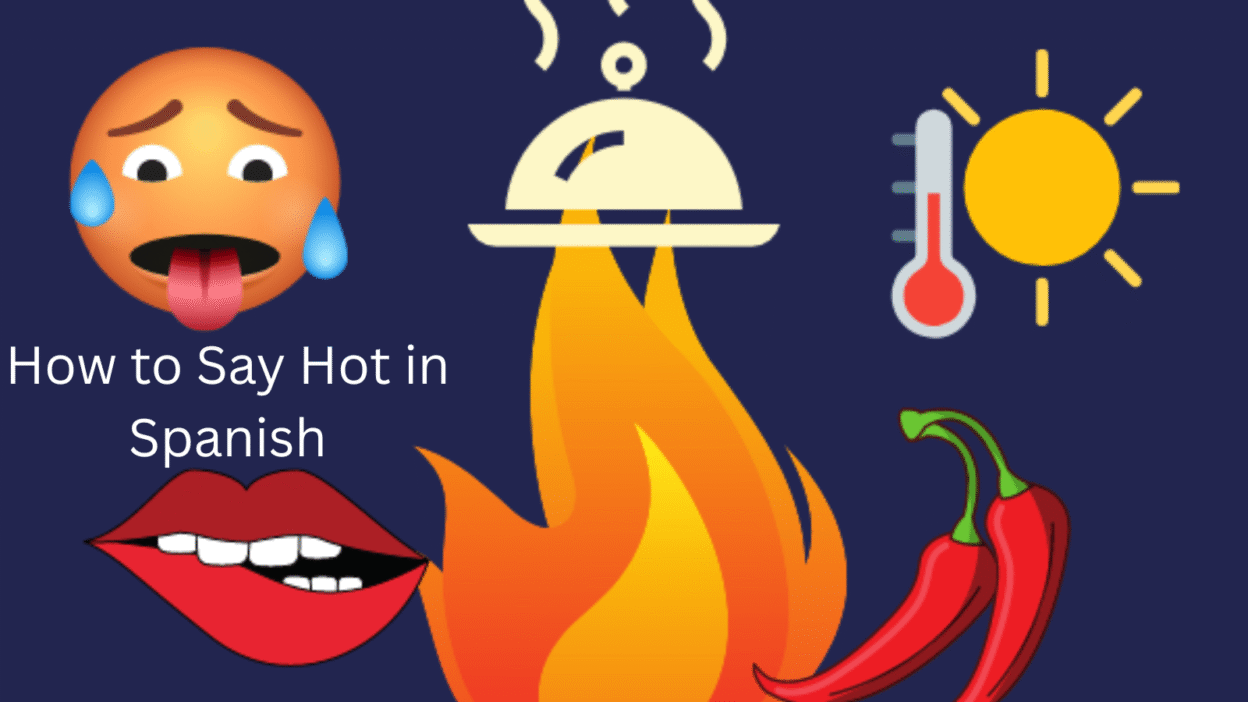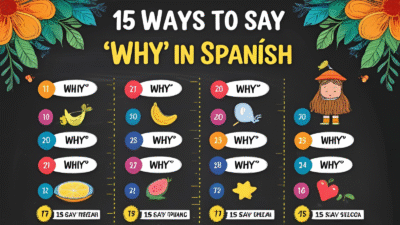If you’re learning Spanish, knowing how to say hot in Spanish is very useful. You can use it to talk about the weather, food, drinks, or even describe someone or something. The most common word is simple and easy to remember, and it helps you sound natural in everyday conversations. In this guide, you’ll learn the main word, its variations, and how to use it correctly in real life.
In this guide, we’ll explore how to say hot in Spanish in all these situations so you can use the right word every time.
Learning how to say hot in Spanish will help you speak more accurately in everyday conversations. You’ll know which word to choose when talking about the weather, food, or people. By mastering how to say hot in Spanish, you’ll avoid misunderstandings and sound more natural. Whether traveling, studying, or chatting with Spanish speakers, how to say hot in Spanish is a phrase you’ll use often.
Say Hot in Spanish:
Here are 15 different ways to say Hot in Spanish, with example dialogues and notes on where they come from and when to use them.
1. Caliente – Hot (Temperature or Spicy)
Origin:
From Latin calens, meaning “warm” or “burning.” It’s the most common word for “hot.”
Example:
👤 User A: ¡Cuidado! El café está caliente.
👤 User B: ¡Ay! Gracias por avisar.
Use: For objects, food, or drinks that are physically hot.
2. Hace calor – It’s hot (Weather)

Origin:
A phrase structure unique to Spanish. Literally “It makes heat.”
Example:
👤 User A: ¿Salimos ahora?
👤 User B: Uf, no. Hace mucho calor afuera.
Use: For talking about hot weather.
3. Picante – Spicy (Food)
Origin:
From picar, meaning “to sting” or “to bite.” Used for spicy food.
Example:
👤 User A: ¿Este taco es picante?
👤 User B: Sí, pica bastante. ¡Ten cuidado!
Use: For spicy flavor—not temperature.
4. Caluroso/a – Hot (Climate/Day/Environment)

Origin:
Describes the heat of a place or situation. More literary or descriptive.
Example:
👤 User A: Hoy fue un día caluroso, ¿no?
👤 User B: Sí, ¡más de 35 grados!
Use: Weather, climates, or days—not people or objects.
5. Candente – Burning/Controversial
Origin:
Used figuratively and literally. From Latin candens, “glowing.”
Example:
👤 User A: Es un tema candente en la política.
👤 User B: Sí, todos están hablando de eso.
Use: Hot topics, heated debates, or glowing-hot objects.
6. Ardiente – Fiery/Passionate
Origin:
From arder, “to burn.” Often used in poetic or romantic expressions.
Example:
👤 User A: Tenía una mirada ardiente.
👤 User B: ¡Qué intenso!
Use: Passion, fire, or intense emotions.
7. Está que arde – It’s burning hot

Origin:
An idiomatic expression, literally “It’s about to catch fire.”
Example:
👤 User A: ¡Este cuarto está que arde!
👤 User B: Prendamos el ventilador ya.
Use: Informal, for stuffy or super hot rooms.
8. Tórrido/a – Scorching/Torrid
Origin:
Used in both weather and steamy romance novels.
Example:
👤 User A: Pasaron una noche tórrida en la playa.
👤 User B: ¡Eso suena intenso!
Use: Literary or dramatic language, often romantic or poetic.
9. Calentito/a – Nice and warm (Diminutive)
Origin:
A softer form of caliente, commonly used in Spain.
Example:
👤 User A: Aquí tienes el pan calentito.
👤 User B: ¡Qué rico, gracias!
Use: Affectionate term for pleasantly warm food or items.
10. Está hirviendo – It’s boiling

Origin:
From hervir, “to boil.” Used literally and figuratively.
Example:
👤 User A: No toques la olla, está hirviendo.
👤 User B: ¡Ups! Gracias por avisar.
Use: For liquids or when something is extremely hot.
11. Calentón – Heatwave / Also: arousal (slang)
Origin:
Be careful! In some regions, it’s used humorously or sexually.
Example:
👤 User A: Este verano vino con un buen calentón.
👤 User B: ¡Sí, no se aguanta!
Use: Colloquial for extreme heat, but check regional meaning.
12. Chiloso – Spicy (Mexico, slang)
Origin:
From chile (pepper). Mostly Mexican slang.
Example:
👤 User A: ¿Está chiloso el pozole?
👤 User B: ¡Un poquito, pero rico!
Use: Used in Mexico for spicy food.
13. Hot (as slang) – Attractive (borrowed English)
Origin:
In youth culture and online, some Spanish speakers use “hot” in English.
Example:
👤 User A: ¿Viste a su nuevo novio?
👤 User B: ¡Está hot!
Use: Urban slang in Spanglish-speaking communities.
14. Está que quema – It’s so hot it burns
Origin:
Idiom meaning “burning hot.”
Example:
👤 User A: ¡Este metal está que quema!
👤 User B: Sí, déjalo enfriar.
Use: Intense heat, used for objects or extreme temperature.
15. Está encendido/a – It’s lit/on fire (figuratively)
Origin:
From encender – “to light.” In slang, it also means someone is fired up or attractive.
Example:
👤 User A: Esa chica está encendida en la pista.
👤 User B: ¡Baila con todo!
Use: Slang for passionate or high-energy people/events.
FAQs
- What is the basic word for hot in Spanish?
The most common word is “Caliente.” - How do you pronounce “Caliente”?
It’s pronounced kah-lyen-teh. - Can “Caliente” be used for weather?
Yes, you can say “Hace calor” for “It’s hot” when talking about weather. - What is the difference between “Caliente” and “Calor”?
Caliente usually describes something physically hot (food, drinks, objects).
Calor refers to hot weather or temperature. - How do you say “The water is hot” in Spanish?
You can say “El agua está caliente.” - How do you say “It’s very hot today” in Spanish?
Say “Hace mucho calor hoy.” - Can “Caliente” describe a person?
Yes, informally, it can describe someone attractive, but context matters. - Is “Caliente” formal or informal?
It’s neutral, but be careful when using it to describe people. - How do you say “Hot coffee” in Spanish?
Say “Café caliente.” - Can “Calor” be used in all Spanish-speaking countries?
Yes, it’s understood everywhere when talking about heat or temperature.
Conclusion:
Now that you’ve learned how to say hot in Spanish, you can confidently describe temperature, spiciness, or even someone’s attractiveness in the right way.Understanding the different words for hot will help you sound natural and accurate in any conversation.Keep practicing how to say hot in Spanish so it becomes second nature in your speech. Whether you’re talking about a sunny day, a spicy dish, or a compliment, you’ll know exactly how to express it in Spanish.



